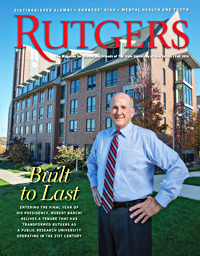 Rutgers 250th Anniversary Video Highlights Paul Robeson
Rutgers 250th Anniversary Video Highlights Paul RobesonPaul Robeson, shown here in his Rutgers College 1919 Scarlet Letter yearbook photo, was a standout student-athlete at Rutgers who became a world-renowned actor and activist. He has been heralded as “the most talented person of the 20th century” for his work in theater and film, and as an outspoken advocate for social justice.
Watch this video segment created to honor Robeson during Rutgers 250th Anniversary. The short is narrated by Natalie Morales, an NBC Today and Access Hollywood anchor and Rutgers alumna who majored in journalism and Latin American studies. Read about Robeson.
Photo: Special Collections and University Archives, Rutgers University Libraries
 Robeson Plaza Unveiled on College Avenue Campus
Robeson Plaza Unveiled on College Avenue CampusThe Rutgers community, including staff, faculty, alumni, and students, gathered on April 12 for the unveiling of Paul Robeson Plaza—venerating one of the university's most esteemed alumnus. Located adjacent to Voorhees Mall on the College Avenue Campus of Rutgers–New Brunswick, this special space commemorates Robeson's life and legacy. The plaza was envisioned and championed by the Class of 1971 for its 45th anniversary, with strong support from the Rutgers African-American Alumni Alliance (RAAA), Inc. Learn more about Paul Robeson Plaza dedication.
 Robeson Awarded Scholarship to Rutgers
Robeson Awarded Scholarship to RutgersPaul Robeson (RC1919), far left, is in action on the field. Robeson, born in Princeton, New Jersey, was the youngest son of the Rev. William D. Robeson, who was born a slave. Robeson's mother, Maria Louisa Bustill, was a teacher and died when he was five. With stellar grades at Somerville High School, Robeson earned a four-year academic scholarship to Rutgers. He enrolled in 1915 at the age of 17—becoming the third African-American student to attend the university.
Photo: Special Collections and University Archives, Rutgers University Libraries
 Confronting Racism
Confronting RacismA member of the Big Ten athletic conference Rutgers is hailed as the birthplace of college football. In 1869, Princeton and Rutgers played the first college football game. Some 50 years later when Paul Robeson joined the Rutgers football team, he became the university's first black football player. He confronted racial hatred from opposing teams—some refusing to take the field with Robeson—and also from his own teammates. He was hazed so unmercifully his freshman year that he loses several fingernails when his own teammates stomp his hands during pileups.
Photo: Special Collections and University Archives, Rutgers University Libraries
 The Scholar
The ScholarPaul Robeson, left, excelled as a student at Rutgers. He garnered honors for his debate and oratorical abilities, and also sang in the Rutgers Glee Club. He was inducted into the Phi Beta Kappa Society, one of America's oldest and most prestigious academic honor societies, and Rutgers’ Cap and Skull Honor Society, which each year, since 1900, has recognized a few select students for achievements in the arts, academics, and athletics. He graduated from Rutgers College in 1919 with honors and gave the concluding speech during the university commencement ceremony.
Robeson was affectionately referred to as “Robie” by his classmates, who lauded him in the campus newspaper, the Targum: "Paul Robeson made a name and record equalled by none, and now as he faces forth into the world we wish him the same success...May Rutgers never forget this noble son."
Rutgers bestowed upon Robeson an honorary master of arts degree in 1932 and an honorary doctorate of humane letters on his 75th birthday in 1973.
Photo: Special Collections and University Archives, Rutgers University Libraries
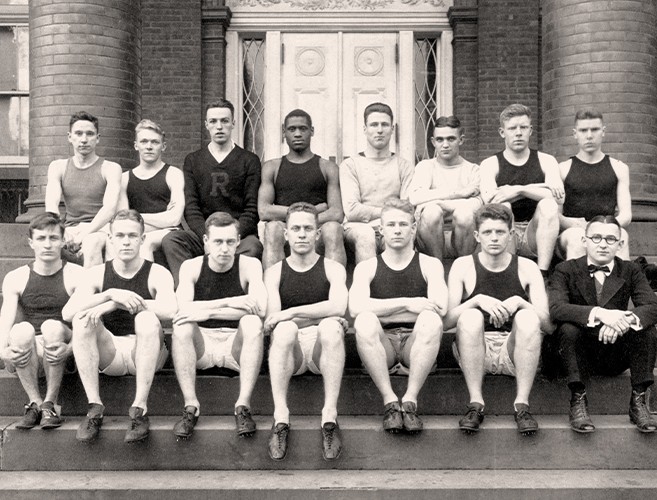 The All-American Athlete
The All-American AthletePaul Robeson, then a junior, is shown here with his fellow track team members. Robeson, who was 6'3, participated in football, basketball, baseball, and track. Excelling in all sports and a proven playmaker, Robeson earned more than a dozen varsity letters during his time at Rutgers. In 1917 and 1918, he was named an All-American football player. Following college, he played pro-football for three years. Robeson was inducted posthumously into the Rutgers Athletics Hall of Fame in 1988 and the College Football Hall of Fame in 1995.
Photo: Special Collections and University Archives, Rutgers University Libraries
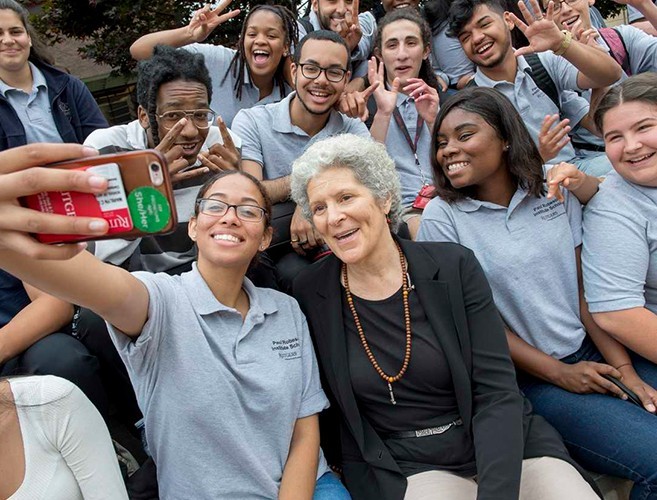 Institute Helps Students Succeed
Institute Helps Students SucceedSusan Robeson, granddaughter of Paul Robeson, is with students participating in the Paul Robeson Leadership Institute. Through the program first-year students at Rutgers University–New Brunswick who are first in their family to attend college and who belong to demographic groups that have been historically underrepresented in higher education have academic support vital to their success.
 A Center for Culture at Rutgers University–New Brunswick
A Center for Culture at Rutgers University–New BrunswickThe Paul Robeson Cultural Center, founded in 1967 at Rutgers, is widely recognized as the first black cultural center on any university campus in the country. The center is located on the Busch campus at Rutgers University–New Brunswick and serves as a hub of activity for student groups, cultural awareness, and familiarity for all students. Learn more about the center in this video.
Annually, the Paul Robeson Cultural Center hosts the pre-Commencement Rites of Passage Ceremony, pictured here, now in its 27th year, to honor the academic accomplishments of our black and Latinx-identified students. During the ceremony, each graduate is presented with a Kente cloth stole—a symbolic “passing of the torch”—to acknowledge that achievement is made possible by the support of family, friends, and loved ones and in recognition of the contributions of the ancestors on whose shoulders the students stand in pursuit of their goals.
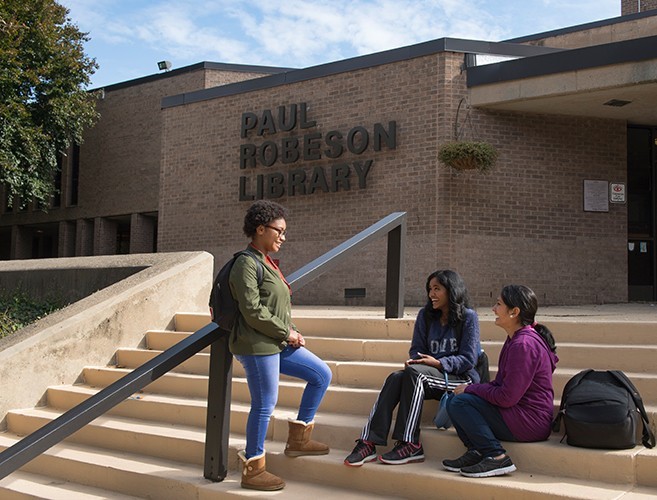 Where We Study and Learn at Rutgers University–Camden
Where We Study and Learn at Rutgers University–CamdenThe Paul Robeson Library at Rutgers University–Camden, located at 300 Fourth Street, provides access to global resources through Rutgers University Libraries, one of the top academic research library systems in the country serving over two million users each year onsite and many more digitally. At the library, visitors can access computers, reserve study rooms, take in cultural events, and more.
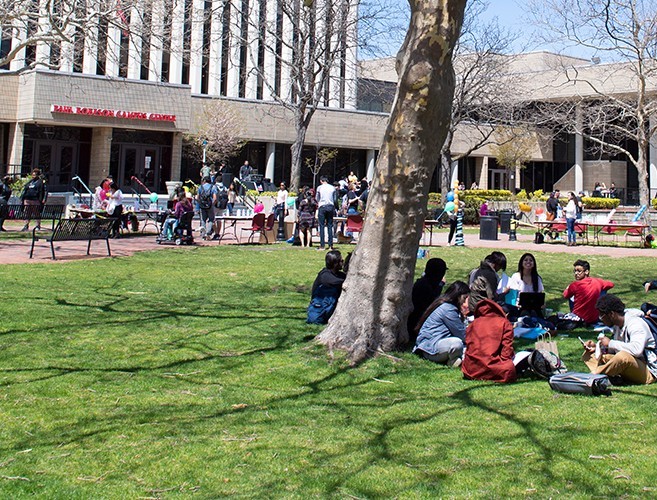 A Hub of Activity at Rutgers University–Newark
A Hub of Activity at Rutgers University–NewarkThe Paul Robeson Campus Center at Rutgers University–Newark is the heart of student life through its many student organizations and boards, venues for performances and conferences, free public art galleries, and leadership programs. Located at 350 Martin Luther King Jr. Boulevard in Newark, New Jersey, the Robeson Center is a hub of activity both for Rutgers–Newark’s predominantly commuter student body, community organizations, and collaborations between university and community.
Designed by the Newark-based architectural firm Frank Grad & Sons in 1965, the center opened in 1967 to favorable reviews from users and architectural critics alike. Visitors are greeted inside the building’s main entrance by a bust of Robeson encased with images and memorabilia evoking his signature contributions to his alma mater and his enduring impact on the university and the world. Where the opposite side of the building fronts the university’s quadrangle, the center’s steps serve as a stage for communitywide gatherings, poetically continuing Robeson’s legacy of promoting public dialogue and social action to address the great challenges of the day, especially in the pursuit of equity and inclusion for people of all backgrounds. Having been expanded substantially since its opening, today the center is home to the university’s Division of Student Affairs, which uses the center to foster holistic student development and provide a place where people meet on a common ground to share their abilities, ideas, talents, and interests as part of a global society.
 Giving Voice through the Arts
Giving Voice through the ArtsEstablished in 1979, the Paul Robeson Galleries curates art and cultural artifacts that embody Paul Robeson's life-long commitment to unfettered artistic freedom, cultural democracy, and transnationalism. The gallery, hosted at Rutgers University–Newark, provides educational and public programming for spaces across the university and in the community.
Artwork: Tatyana Fazlalizadeh, "Stop Telling Women to Smile" (installation view), 2018, wheat paste installation, dimensions variable, courtesy of the artist
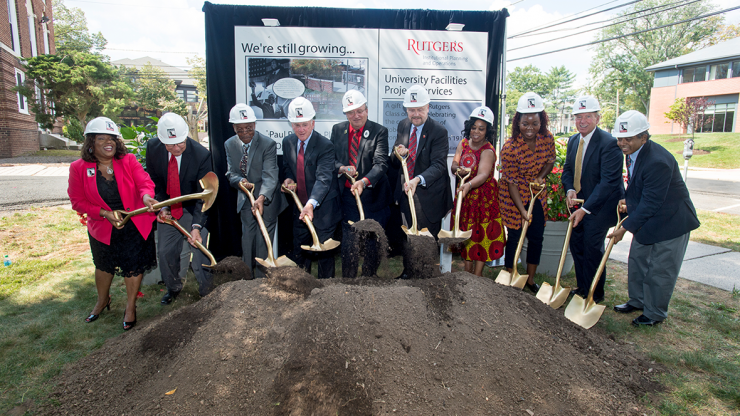 Robeson Plaza Groundbreaking
Robeson Plaza GroundbreakingOn September 5, 2018, the university broke ground on Paul Robeson Plaza, which was conceived and championed by the Rutgers College Class of 1971 in recognition of its 45th Anniversary—and as a way to honor Robeson. The Class led a three-year fundraising effort with assistance from the Rutgers African-American Alumni Alliance. Once completed, the plaza will be located on the College Avenue campus at Rutgers University–New Brunswick (adjacent to Seminary Place) and will showcase excerpts from Robeson's 1919 Valedictory Address and images exemplifying his accomplishments.
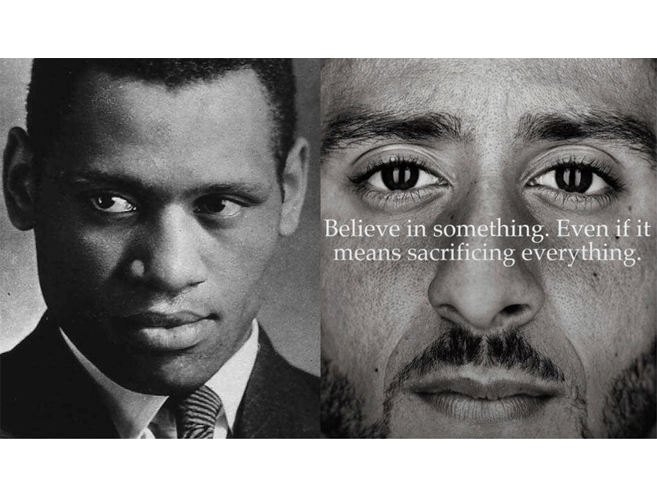 An Op-Ed: Before Colin Kaepernick, There Was Paul Robeson
An Op-Ed: Before Colin Kaepernick, There Was Paul RobesonDavid E. Jones, director of the Paul Robeson Cultural Center at Rutgers–New Brunswick, explores how Paul Robeson’s legacy connects with those using their influence to speak up for social justice today. Read Jones's op-ed on NJ.com to find out why the Rutgers alumnus's example remains so resonant.
Photo: Courtesy of NJ.com
 1/13
1/13 2/13
2/13 3/13
3/13 4/13
4/13 5/13
5/13 6/13
6/13 7/13
7/13 8/13
8/13 9/13
9/13 10/13
10/13 11/13
11/13 12/13
12/13 13/13
13/13
